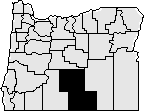
Lake County was established Oct. 24, 1874. It was created from the southern part of Wasco County and the eastern part of Jackson County. It was named because of the many large lakes within its borders.
Lake County is in south central Oregon. The western boundary was changed with the creation of Klamath County in 1882. It regained some area when the southwestern part of Grant County was annexed in 1885. It currently has 8,275 square miles. Lake County is bounded on the north by Deschutes County, on the east by Harney County, on the west by Klamath County, and on the south by the states of California and Nevada.
When the Legislative Assembly created Lake County, it temporarily located the county seat at Linkville (now Klamath Falls) until voters selected a permanent site. The voters chose to move the county seat to Lakeview in 1876. The town derived its name from its view of Goose Lake to the south. The shallow lake, known for its fluctuating size, was generally much larger and closer to Lakeview in the 1870s than it is today.
The land for the first courthouse was donated by one of the areas first settlers, M.W. Bullard. The first courthouse was completed in 1904. In 1954 a new courthouse was built on the site of the former courthouse at a cost of $366,427.
The government of Lake County consisted originally of a county judge, a county commissioner, clerk, treasurer, and sheriff. Another commissioner, assessor, school superintendent, and surveyor were later added. The county court was abolished and replaced with a board of county commissioners by 1971.
The 1875 Lake County census showed a population of 944, which jumped to 2,804 by 1880. Since then there has been some fluctuation in population, but steady growth to a population of 7,940 in 2013. This was a 0.6% increase over the 2010 population.
Because of poor transportation connections with the rest of Oregon, the early economic orientation of Lake County was toward California. During the 1840s and 1850s the county was part of the military courier route between The Dalles on the Columbia River and the Presidio in San Francisco. The county did not acquire a railroad connection until the 1890s.
The traditional county economy rests on lumber, agriculture, and government. In spite of the low rainfall and a short growing season, a combination of homesteading and irrigation has permitted agriculture based upon the raising of livestock and the growing of hay and grain to thrive. Lumber and wood products are taken from the Fremont National Forest. Government employees from the national forest and the regional BLM headquarters create a more stable economic base for the county that otherwise would have to rely only on seasonal agricultural and lumber jobs. Tourism is a growing industry because of the county's many interesting sites, including Hart Mountain Antelope Refuge, Hunter's Hot Springs, Goose Lake, and areas for rock hunting and hang gliding.